Vincent van Gogh
From Wikipedia, the free encyclopedia
"Van Gogh" redirects here. For other uses, see Van Gogh (disambiguation).
| Vincent van Gogh | |
|---|---|

Self-Portrait with Straw Hat, Paris, Winter 1887/88, Metropolitan Museum of Art, (F365v)
|
|
| Birth name | Vincent Willem van Gogh |
| Born | 30 March 1853 Zundert, Netherlands |
| Died | 29 July 1890 (aged 37) Auvers-sur-Oise, France |
| Field | Painting, drawing |
| Training | Anton Mauve |
| Movement | Post-Impressionism |
| Works | Starry Night, Sunflowers, Bedroom in Arles, Portrait of Dr. Gachet, Sorrow |
Van Gogh began to draw as a child, and he continued to draw throughout the years that led up to his decision to become an artist. He did not begin painting until his late twenties, completing many of his best-known works during the last two years of his life. In just over a decade, he produced more than 2,100 artworks, consisting of 860 oil paintings and more than 1,300 watercolors, drawings, sketches and prints. His work included self portraits, landscapes, still lifes, portraits and paintings of cypresses, wheat fields and sunflowers.
Van Gogh spent his early adulthood working for a firm of art dealers, traveling between The Hague, London and Paris, after which he taught for a time in England at Isleworth and Ramsgate. One of his early aspirations was to become a pastor and from 1879 he worked as a missionary in a mining region in Belgium where he began to sketch people from the local community. In 1885, he painted his first major work The Potato Eaters. His palette at the time consisted mainly of somber earth tones and showed no sign of the vivid coloration that distinguished his later work. In March 1886, he moved to Paris and discovered the French Impressionists. Later, he moved to the south of France and was influenced by the strong sunlight he found there. His work grew brighter in color, and he developed the unique and highly recognizable style that became fully realized during his stay in Arles in 1888.
The extent to which his mental health affected his painting has been a subject of speculation since his death. Despite a widespread tendency to romanticize his ill health, modern critics see an artist deeply frustrated by the inactivity and incoherence brought about by his bouts of illness. According to art critic Robert Hughes, Van Gogh's late works show an artist at the height of his ability, completely in control and "longing for concision and grace."[4]
Contents
Letters
See also: The Letters of Vincent van Gogh
Vincent c. 1871–1872 aged 18. This photograph was taken at the time when he was working at the branch of Goupil & Cie's gallery in The Hague.[5][6]
Theo in 1888 at 31. Theo was a life-long supporter and friend to his brother. The two are buried together at Auvers-sur-Oise.
Although many are undated, art historians have generally been able to put them in chronological order. Problems remain, mainly in dating those from Arles, although it is known that during that period, Van Gogh wrote 200 letters to friends in Dutch, French and English.[10] The period when Vincent lived in Paris is the most difficult for historians to analyze because the brothers lived together and had no need to correspond.[11]
In addition to letters to and from Theo, other surviving documents include those to Van Rappard, Émile Bernard, Van Gogh's sister Wil and her friend Line Kruysse.[12] The letters were first annotated in 1913 by Theo's widow Johanna van Gogh-Bonger who explained that she published them with 'trepidation' because she did not want the drama in the artist's life to overshadow his work. Van Gogh himself was an avid reader of other artists' biographies and expected their lives to be in keeping with the character of their art.[7]
Biography
Main article: Vincent van Gogh chronology
Early life
See also: Van Gogh's family in his art
Vincent Willem van Gogh was born on 30 March 1853 in Groot-Zundert, a village close to Breda in the province of North Brabant in the south of the Netherlands, a predominantly Catholic area.[13][14] He was the oldest child of Theodorus van Gogh, a minister of the Dutch Reformed Church,
and Anna Cornelia Carbentus. Vincent was given the name of his
grandfather, and of a brother stillborn exactly a year before his birth.[note 3]The practice of reusing a name was not unusual. Vincent was a common name in the Van Gogh family: his grandfather, Vincent (1789–1874), had received his degree of theology at the University of Leiden in 1811. Grandfather Vincent had six sons, three of whom became art dealers, including another Vincent who was referred to in Van Gogh's letters as "Uncle Cent." Grandfather Vincent had perhaps been named in turn after his own father's uncle, the successful sculptor Vincent van Gogh (1729–1802).[15][16] Art and religion were the two occupations to which the Van Gogh family gravitated. His brother Theodorus "Theo" was born on 1 May 1857. He had another brother, Cor, and three sisters: Elisabeth, Anna and Willemina "Wil."[17]
As a child, Vincent was serious, silent and thoughtful. He attended the Zundert village school from 1860, where the single Catholic teacher taught around 200 pupils. From 1861, he and his sister Anna were taught at home by a governess, until 1 October 1864, when he went to Jan Provily's boarding school at Zevenbergen about 20 miles (32 km) away. He was distressed to leave his family home as he recalled later as an adult. On 15 September 1866, he went to the new middle school, Willem II College in Tilburg. Constantijn C. Huysmans, a successful artist in Paris, taught Van Gogh to draw at the school and advocated a systematic approach to the subject. Vincent's interest in art began at an early age. He began to draw as a child and continued making drawings throughout the years leading to his decision to become an artist. Though well-done and expressive,[18] his early drawings do not approach the intensity he developed in his later work.[19] In March 1868, Van Gogh abruptly left school and returned home. A later comment on his early years was in an 1883 letter to Theo in which he wrote, "My youth was gloomy and cold and sterile."[20]

Van Gogh's drawing of 87 Hackford Road
Van Gogh returned to England for unpaid work as a supply teacher in a small boarding school overlooking the harbor in Ramsgate, where he made sketches of the view. When the proprietor of the school relocated to Isleworth, Middlesex, Van Gogh moved with him, taking the train to Richmond and the remainder of the journey on foot.[23] The arrangement did not work out and he left to become a Methodist minister's assistant, following his wish to "preach the gospel everywhere."[24] At Christmas, he returned home and found work in a bookshop in Dordrecht for six months. He was not happy in this new position and spent much of his time either doodling or translating passages from the Bible into English, French and German.[25] His roommate at the time, a young teacher named Görlitz, recalled that Van Gogh ate frugally, and preferred not to eat meat.[26][note 4]
Van Gogh's religious zeal grew until he felt he had found his true vocation. To support his effort to become a pastor, his family sent him to Amsterdam to study theology in May 1877, where he stayed with his uncle Jan van Gogh, a naval Vice Admiral.[27][28] Vincent prepared for the entrance exam with his uncle Johannes Stricker; a respected theologian who published the first "Life of Jesus" in the Netherlands. Van Gogh failed the exam, and left his uncle Jan's house in July 1878. He then undertook, but failed, a three-month course at the Vlaamsche Opleidingsschool, a Protestant missionary school in Laeken, near Brussels.[29]

The house where Van Gogh stayed in Cuesmes in 1880; while living here he decided to become an artist
He returned to Cuesmes where he lodged until October with a miner named Charles Decrucq.[32] Increasingly interested in the people and scenes around him, Van Gogh recorded his time there in his drawings and followed Theo's suggestion that he should take up art in earnest. He traveled to Brussels that autumn intending to follow Theo's recommendation to study with the prominent Dutch artist Willem Roelofs, who persuaded him, in spite of his aversion to formal schools of art, to attend the Académie Royale des Beaux-Arts in Brussels, where he registered on 15 November 1880. At the Académie, he studied anatomy and the standard rules of modeling and perspective, about which he said, "...you have to know just to be able to draw the least thing."[33] Van Gogh aspired to become an artist in God's service, stating: "...to try to understand the real significance of what the great artists, the serious masters, tell us in their masterpieces, that leads to God; one man wrote or told it in a book; another in a picture."
Etten, Drenthe and The Hague
See also: Early works of Vincent van Gogh

Annotated by the artist in ink at lower left: At Eternity's Gate, 1882, lithograph, Tehran Museum of Contemporary Art[34]
In January 1882, he settled in The Hague where he called on his cousin-in-law, Anton Mauve (1838–88), who was a Dutch realist painter and a leading member of the Hague School. Mauve introduced him to painting in both oil and watercolor and lent him money to set up a studio[46] but the two soon fell out, possibly over the issue of drawing from plaster casts.[47] Mauve appears to have suddenly gone cold towards Van Gogh and did not return some of his letters.[48] Van Gogh supposed that Mauve had learned of his new domestic arrangement with an alcoholic prostitute, Clasina Maria "Sien" Hoornik (1850–1904), and her young daughter.[49][50][51] He had met Sien towards the end of January when she had a five-year-old daughter and was pregnant. She had already borne two children who had died, although Van Gogh was unaware of this.[52] On 2 July, she gave birth to a baby boy, Willem.[53] When Van Gogh's father discovered the details of their relationship, he put considerable pressure on his son to abandon Sien and her children, although Vincent at first defied him.[54][55]
Van Gogh's uncle Cornelis, an art dealer, commissioned 12 ink drawings of views of the city, which Van Gogh completed soon after arriving in The Hague, along with a further seven drawings that May.[56] In June, he spent three weeks in a hospital suffering from gonorrhea.[57] During the summer he began to paint in oil.[58] In autumn 1883, after a year together, he left Sien and the two children. He had thought of moving the family out of the city but in the end made the break.[59]
It is possible that lack of money pushed Sien back to prostitution; the home became less happy, and Van Gogh may have felt family life was irreconcilable with his artistic development. When he left, Sien gave her daughter to her mother and baby Willem to her brother. She then moved to Delft, and later to Antwerp.[60] Willem remembered being taken to visit his mother in Rotterdam at around the age of 12, where his uncle tried to persuade Sien to marry in order to legitimize the child. Willem remembered his mother saying, "But I know who the father is. He was an artist I lived with nearly 20 years ago in The Hague. His name was Van Gogh." She then turned to Willem and said "You are called after him."[61] While Willem believed himself Van Gogh's son, the timing of his birth makes this unlikely.[62] In 1904, Sien drowned herself in the River Scheldt. Van Gogh moved to the Dutch province of Drenthe, in the northern Netherlands. That December, driven by loneliness, he went to stay with his parents who had been posted to Nuenen, North Brabant.[63]
Emerging artist
Nuenen and Antwerp (1883–1886)
From this period, Still-Life with Straw Hat and Pipe and Still-life with Earthen Pot and Clogs are characterized by smooth, meticulous brushwork and fine shading of colors.[68] During his two-year stay in Nuenen, he completed numerous drawings and watercolors and nearly 200 oil paintings. His palette consisted mainly of somber earth tones, particularly dark brown, and he showed no sign of developing the vivid coloration that distinguishes his later, best-known work. When he complained that Theo was not making enough effort to sell his paintings in Paris, his brother wrote back, telling him that the paintings were too dark and not in line with the current style of bright Impressionist paintings.[69]
In November 1885, he moved to Antwerp and rented a small room above a paint dealer's shop in the Rue des Images (Lange Beeldekensstraat).[70] He had little money and ate poorly, preferring to spend the money Theo sent on painting materials and models. Bread, coffee and tobacco were his staple intake. In February 1886, he wrote to Theo saying that he could only remember eating six hot meals since May of the previous year. His teeth became loose and painful.[71] While in Antwerp he applied himself to the study of color theory and spent time in museums, particularly studying the work of Peter Paul Rubens, gaining encouragement to broaden his palette to carmine, cobalt and emerald green. He bought Japanese Ukiyo-e woodcuts in the docklands, and incorporated their style into the background of some of his paintings.[72] While in Antwerp, Van Gogh began to drink absinthe heavily.[73] He was treated by Dr. Amadeus Cavenaile, whose practice was near the docklands,[note 10] possibly for syphilis;[note 11] the treatment of alum irrigation and sitz baths was jotted down by Van Gogh in one of his notebooks.[74] Despite his rejection of academic teaching, he took the higher-level admission exams at the Academy of Fine Arts in Antwerp, and in January 1886, matriculated in painting and drawing. For most of February, he was ill and run down by overwork, a poor diet and excessive smoking.[75]
Paris (1886–1888)
Courtesan (after Eisen), 1887, Van Gogh Museum
The Blooming Plumtree (after Hiroshige), 1887, Van Gogh Museum
During his stay in Paris, he collected more Japanese ukiyo-e woodblock prints; he became interested in such works, when in 1885 in Antwerp he used them to decorate the walls of his studio. He collected hundreds of prints, which are visible in the backgrounds of several of his paintings. In his 1887 Portrait of Père Tanguy several can be seen hanging on the wall behind the main figure. In The Courtesan or Oiran (after Kesai Eisen) (1887), Van Gogh traced the figure from a reproduction on the cover of the magazine Paris Illustre, which he then graphically enlarged in the painting.[77] His 1888 Plum Tree in Blossom (After Hiroshige) is a vivid example of the admiration he had for the prints he collected. His version is slightly bolder than Hiroshige's original.[78]
After seeing Adolphe Joseph Thomas Monticelli's work at the Galerie Delareybarette, which he admired, Van Gogh immediately adopted a brighter palette and a bolder attack, particularly in paintings such as his Seascape at Saintes-Maries (1888).[79][80] Two years later, in 1890, Vincent and Theo paid to have a book about Monticelli published, and Van Gogh bought some of Monticelli's paintings, adding them to his collection.[81]
Conflicts arose between the brothers. At the end of 1886 Theo found that living with Vincent was "almost unbearable." By the spring of 1887, they were again at peace, although Van Gogh moved to Asnières a northwestern suburb of Paris, where he became acquainted with Signac. With Émile Bernard he adopted elements of pointillism, a technique in which a multitude of small colored dots are applied to the canvas that, when seen from a distance, create an optical blend of hues.[84] The style stresses the value of complementary colors – including blue and orange – to form vibrant contrasts that are enhanced when juxtaposed.[85] While in Asnières he painted parks and restaurants and the Seine, including Bridges across the Seine at Asnieres.
In November 1887, Theo and Vincent met and befriended Paul Gauguin who had just arrived in Paris.[86] Towards the end of the year, Vincent arranged an exhibition of paintings by himself, Bernard, Anquetin, and probably Toulouse-Lautrec in the Grand-Bouillon Restaurant du Chalet, 43 Avenue de Clichy, in Montmartre. In a contemporary account, Émile Bernard wrote of the event: "On the avenue de Clichy a new restaurant was opened. Vincent used to eat there. He proposed to the manager that an exhibition be held there .... Canvases by Anquetin, by Lautrec, by Koning ...filled the hall....It really had the impact of something new; it was more modern than anything that was made in Paris at that moment."[87] There Bernard and Anquetin sold their first paintings, and Van Gogh exchanged work with Gauguin who soon departed to Pont-Aven. Discussions on art, artists and their social situations that started during this exhibition continued and expanded to include visitors to the show like Pissarro and his son Lucien, Signac and Seurat. Finally in February 1888, feeling worn out from life in Paris, he left, having painted over 200 paintings during his two years in the city. Only hours before his departure, accompanied by Theo, he paid his first and only visit to Seurat in his atelier (studio).[88]
Artistic breakthrough and final years
Move to Arles (1888–1889)
The Yellow House, 1888, Van Gogh Museum
Bedroom in Arles, 1888, Van Gogh Museum
Van Gogh was enchanted by the local landscape and light, and his works from the period are richly draped in yellow, ultramarine and mauve. His portrayals of the Arles landscape are informed by his Dutch upbringing; the patchwork of fields and avenues appear flat and lack perspective, but excel in their intensity of color.[10][89] The vibrant light in Arles excited him, and his newfound appreciation is seen in the range and scope of his work. That March he painted local landscapes using a gridded "perspective frame." Three of these paintings were shown at the annual exhibition of the Société des Artistes Indépendants. In April, he was visited by the American artist Dodge MacKnight, who was living nearby at Fontvieille.[5][92] On 1 May, he signed a lease for 15 francs a month in the eastern wing of the Yellow House at No. 2 Place Lamartine. The rooms were unfurnished and uninhabited for some time. He was still at the Hôtel Restaurant Carrel, but the rate charged by the hotel was 5 francs a week, which he found excessive. He disputed the price, took the case to a local arbitrator and was awarded a twelve franc reduction on the total bill.[93]
The Night Café, 1888, Yale University Art Gallery, New Haven
Paul Gauguin's Armchair, 1888, Van Gogh Museum
When he visited Saintes-Maries-de-la-Mer that June he gave drawing lessons to a Zouave second lieutenant, Paul-Eugène Milliet[98] and painted boats on the sea and the village.[99] MacKnight introduced Van Gogh to Eugène Boch, a Belgian painter who stayed at times in Fontvieille, and the two exchanged visits in July.[98]
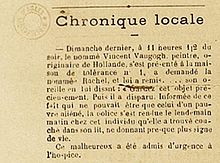
Local newspaper report dated 30 December 1888 recording Vincent's self-mutilation.[100] Last Sunday night at half past eleven a painter named Vincent Vangogh, appeared at the maison de tolérance
No 1, asked for a girl called Rachel, and handed her ... his ear with
these words:'Keep this object like a treasure.' Then he disappeared. The
police, informed of these events, which could only be the work of an
unfortunate madman, looked the next morning for this individual, whom
they found in bed with scarcely a sign of life.
The poor man was taken to hospital without delay.[101]
The poor man was taken to hospital without delay.[101]
Gauguin's visit
See also: Hospital in Arles (Van Gogh series)
Still Life: Vase with Twelve Sunflowers, August 1888, Neue Pinakothek, Munich
The Café Terrace on the Place du Forum, Arles, at Night, September 1888, Kröller-Müller Museum, Otterlo, The Netherlands
Van Gogh's Chair, 1888, National Gallery, London
After repeated requests, Gauguin finally arrived in Arles on 23 October. During November, the two painted together. Gauguin painted Van Gogh's portrait The Painter of Sunflowers: Portrait of Vincent van Gogh, and uncharacteristically, Van Gogh painted some pictures from memory – deferring to Gauguin's ideas in this – as well as his The Red Vineyard. Notable amongst these "imaginative" paintings is Memory of the Garden at Etten.[108][109] Their first joint outdoor painting exercise produced Les Alyscamps, and was conducted at the Alyscamps.[110]
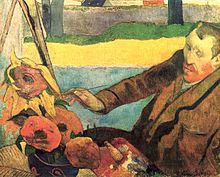
Paul Gauguin, The Painter of Sunflowers: Portrait of Vincent van Gogh, 1888, Van Gogh Museum, Amsterdam.
The precise chain of events that led to the celebrated incident of van Gogh slicing off his ear is not known reliably in detail. The only account attesting a supposed earlier razor attack on Gauguin comes from Gauguin himself some fifteen years later and biographers agree this account must be considered unreliable and self-serving.[113][114][115] It does seem likely, however, that by 23 December 1888 van Gogh had realized that Gauguin was proposing to leave and that there had been some kind of contretemps between the two.[116] That evening van Gogh severed his left ear (wholly or in part, accounts differ) with a razor, inducing a severe haemorrhage.[note 12] He bandaged his wound and then wrapped the ear in paper and delivered the package to a brothel frequented by both him and Gauguin before returning home and collapsing. He was found unconscious the next day by the police [note 13] and taken to hospital.[117][118][119] The local newspaper reported that van Gogh had given the ear to a prostitute with an instruction to guard it carefully.[120] In Gauguin's later account he implies that in fact van Gogh had left it with the doorman as a memento for Gauguin.[113] Van Gogh himself had no recollection of these events and it is plain that he had suffered an acute psychotic episode.[121] Family letters of the time make it clear that the event had not been unexpected.[122] He had suffered a nervous collapse in Antwerp some three years before and as early as 1880 his father had proposed committing him to an asylum (at Gheel).[123] The hospital diagnosis was "generalized delirium", and within a few days van Gogh was sectioned.[122]
During the initial few days of his treatment van Gogh repeatedly asked for Gauguin, but Gauguin stayed away. Gauguin told one of the policeman attending the case, "Be kind enough, Monsieur, to awaken this man with great care, and if he asks for me tell him I have left for Paris; the sight of me might prove fatal for him."[124] Gauguin wrote of Van Gogh, "His state is worse, he wants to sleep with the patients, chase the nurses, and washes himself in the coal bucket. That is to say, he continues the biblical mortifications."[124][122] Theo – notified by Gauguin – visited, as did both Madame Ginoux and Roulin. Gauguin left Arles and never saw Van Gogh again.[note 14]
Despite the gloomy initial disgnosis, van Gogh made a surprisingly speedy recovery. He returned to the Yellow House by the beginning of January, but was to spend the following month between the hospital and home, suffering from hallucinations and delusions that he was being poisoned. In March, the police closed his house after a petition by 30 townspeople (including the Ginoux family), who called him "fou roux" (the redheaded madman).[122] Paul Signac visited him in the hospital and Van Gogh was allowed home in his company. In April, he moved into rooms owned by his hospital physician Dr. Rey after floods damaged paintings in his own home.[125][126] Around this time, he wrote, "Sometimes moods of indescribable anguish, sometimes moments when the veil of time and fatality of circumstances seemed to be torn apart for an instant." Two months later he left Arles and entered an asylum (at his own request) in Saint-Rémy-de-Provence.[127]
Saint-Rémy (May 1889 – May 1890)
The Round of the Prisoners, 1890, Pushkin Museum, Moscow
Two Peasant Women Digging in a Snow-Covered Field at Sunset, 1890, Foundation E.G. Bührle Collection, Zurich, Switzerland
Main article: Saint-Paul Asylum, Saint-Rémy (Van Gogh series)
The Starry Night, June 1889, The Museum of Modern Art, New York
The Sower, 1888, Kröller-Müller Museum
During his stay, the clinic and its garden became the main subjects of his paintings. He made several studies of the hospital interiors, such as Vestibule of the Asylum and Saint-Remy (September 1889). Some of the work from this time is characterized by swirls – including one of his best-known paintings The Starry Night.[129] He was allowed short supervised walks, which led to paintings of cypresses and olive trees, like Olive Trees with the Alpilles in the Background 1889, Cypresses 1889, Cornfield with Cypresses (1889), Country road in Provence by Night (1890). That September he also produced a further two versions of Bedroom in Arles.
Limited access to the world outside the clinic resulted in a shortage of subject matter. He was left to work on interpretations of other artist's paintings, such as Millet’s The Sower and Noon – Rest from Work (after Millet), as well as variations on his own earlier work. Van Gogh was an admirer of the Realism of Jules Breton, Gustave Courbet and Millet[130] and compared his copies to a musician's interpreting Beethoven.[131][132] Many of his most compelling works date from this period. His The Round of the Prisoners (1890) was painted after an engraving by Gustave Doré (1832–1883). It is suggested that the face of the prisoner in the center of the painting and looking toward the viewer is Van Gogh himself, although the noted Van Gogh scholar Jan Hulsker discounts this.[133][134]
Towards the end of his stay, Van Gogh suffered a severe relapse lasting two month between February and April 1890. Nevertheless he was able to paint and draw a little during this time and he later wrote Theo that he had made a few small canvases "from memory ... reminisces of the North."[135] Amongst these was Two Peasant Women Digging in a Snow-Covered Field at Sunset. Hulsker believes that this small group of paintings formed the nucleus of many drawings and study sheets depicting landscapes and figures that Van Gogh worked on during this time. He comments that, save for this short period, Van Gogh's illness had hardly any effect on his work but in these he sees a reflection of Van Gogh's mental health at the time.[136] Also belonging to this period is Sorrowing Old Man ('At Eternity's Gate'), a color study that Hulsker describes as "another unmistakable remembrance of times long past."[136][137]
In February 1890, he painted five versions of L'Arlésienne (Madame Ginoux), based on a charcoal sketch Gauguin had produced when Madame Ginoux sat for both artists at the beginning of November 1888.[138] The version intended for Madame Ginoux is lost. It was attempting to deliver this painting to Madame Ginoux in Arles that precipitated his February relapse.[139]
His work was praised by Albert Aurier in the Mercure de France in January 1890, when he was described as "a genius."[140] That February he was invited by Les XX, a society of avant-garde painters in Brussels, to participate in their annual exhibition. At the opening dinner, Les XX member Henry de Groux insulted Van Gogh's work. Toulouse-Lautrec demanded satisfaction, while Signac declared he would continue to fight for Van Gogh's honor if Lautrec should surrender. Later, while Van Gogh's exhibit was on display with the Artistes Indépendants in Paris, Monet said that his work was the best in the show.[141] In February 1890, following the birth of his nephew Vincent Willem, he wrote in a letter to his mother, that with the new addition to the family, he "started right away to make a picture for him, to hang in their bedroom, branches of white almond blossom against a blue sky."[142]
Auvers-sur-Oise (May–July 1890)
See also: Double-squares and Squares
In May 1890, Van Gogh left the clinic in Saint-Rémy to move nearer the physician Dr. Paul Gachet in Auvers-sur-Oise, and also to Theo. Gachet was recommended by Camille Pissarro,
had treated several other artists, and was himself an amateur artist.
Van Gogh's first impression was that Gachet was "...sicker than I am, I
think, or shall we say just as much."[144] In June 1890 he painted several portraits of the physician, including Portrait of Dr. Gachet, and his only etching; in each the emphasis is on Gachet's melancholic disposition. Van Gogh stayed at the Auberge Ravoux, where he paid 3 francs and 50 centimes to rent an attic room measuring 75 square feet (7.0 m2).
Wheatfield Under Clouded Sky, July 1890, Van Gogh Museum, Amsterdam, (F778), painted in July 1890 during his last weeks.[145]
The Church at Auvers, 1890, Musée d'Orsay, Paris
Portrait of Dr. Gachet, 1890, was sold for US$ 82.5 million in 1990.[146] Private collection
Wheat Field with Crows (July 1890) is an example of the double square technique he developed in the last weeks of his life. In its turbulent intensity, it is among his most haunting and elemental works.[149] It is often mistakenly believed to be his last work, Hulsker lists seven paintings that postdate it.[150]
Barbizon painter Charles Daubigny had moved to Auvers in 1861, and this in turn drew other artists there, including Camille Corot and Honoré Daumier. In July 1890, Van Gogh completed two paintings of Daubigny's Garden; one of these is likely to be his final work.[143] There are also paintings that show evidence of being unfinished, including Thatched Cottages by a Hill.[149]
Death
Main article: Death of Vincent van Gogh
Self-portrait, 1889, Courtauld Institute Galleries, London. Mirror-image self portrait with bandaged ear
Still Life with Absinthe, 1887, Van Gogh Museum
On 27 July 1890, aged 37, Van Gogh is believed to have shot himself in the chest with a revolver (although no gun was ever found).[152] There were no witnesses and his location when he shot himself is unclear. Ingo Walther writes that "Some think Van Gogh shot himself in the wheat field that had engaged his attention as an artist of late; others think he did it at a barn near the inn."[153] Biographer David Sweetman writes that the bullet was deflected by a rib bone and passed through his chest without doing apparent damage to internal organs—probably stopped by his spine. He was able to walk back to the Auberge Ravoux and was eventually attended to by two physicians, neither of whom was qualified to remove the bullet by surgery. The physicians left Van Gogh alone in his room, smoking his pipe. The following morning (Monday), Theo rushed to be with Van Gogh as soon as he was notified and found him in surprisingly good shape, but within hours Van Gogh began to fail due to an untreated infection caused by the wound. Van Gogh died in the evening, 29 hours after he supposedly shot himself. According to Theo, his brother's last words were: "The sadness will last forever."[152][154]
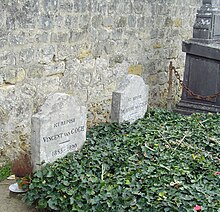
Vincent and Theo buried together in Auvers-sur-Oise. Vincent's stone bears the inscription: Ici Repose Vincent van Gogh (1853–1890), Theo's Ici Repose Theodore van Gogh (1857–1891)
While many of Van Gogh's late paintings are somber, they are essentially optimistic and reflect his desire to return to lucid mental health right up to the time of his death. Yet some of his final works reflect his deepening concerns. Referring to his paintings of wheatfields under troubled skies, he commented in a letter to his brother Theo: "I did not have to go out of my way very much in order to try to express sadness and extreme loneliness." Nevertheless, he adds in the same paragraph: " ... these canvases will tell you what I cannot say in words, that is, how healthy and invigorating I find the countryside."[159][160]
There has been much debate over the years as to the source of Van Gogh's illness and its effect on his work. Over 150 psychiatrists have attempted to label its root, with some 30 different diagnoses.[161] Diagnoses include schizophrenia, bipolar disorder, syphilis, poisoning from swallowed paints, temporal lobe epilepsy and acute intermittent porphyria. Any of these could have been the culprit and been aggravated by malnutrition, overwork, insomnia and consumption of alcohol, especially absinthe.
In Van Gogh: the Life, a biography published in 2011, authors Steven Naifeh and Gregory White Smith argue that Van Gogh did not commit suicide. They contend that he was shot accidentally by two boys he knew who had “a malfunctioning gun”.[162] Experts at the Van Gogh Museum remain unconvinced.[163] Prominent skeptic Joe Nickell also was not convinced.[164] Nickell analyzed the questions raised by Naifeh and Smith to support their new theory and claimed that they could be addressed with more plausible answers. He maintained that Naifeh and Smith ignored the well-known psychological state of Van Gogh, as well as reliable testimony from Adeline Ravoux, daughter of the innkeeper Gustave Ravoux, the owner of the gun. According to Nickell, Naifeh and Smith make many assumptions about the circumstances surrounding the incident. He asserts that they also misrepresent the remarks of Rene Secretan, one of the two boys, who in 1956 admitted to having tormented the artist, but not to having shot him. Nickell concludes that their theory is the result of the logical fallacy of 'confirmation bias' – "start the investigation with a supposed answer and work backward to the evidence."[164]
Work
The Old Mill, 1888, Albright-Knox Art Gallery, Buffalo, NY.
Starry Night Over the Rhone, 1888, Musée d'Orsay, Paris.
Olive Trees with the Alpilles in the Background, 1889, Museum of Modern Art, New York.
Main article: List of works by Vincent van Gogh
Van Gogh drew and painted with watercolors while at school—only a few of these paintings survive and authorship is challenged on some of those that do.[165] When he committed to art as an adult, he began at an elementary level, copying the Cours de dessin, a drawing course edited by Charles Bargue.
Within two years he had begun to seek commissions. In spring 1882, his
uncle, Cornelis Marinus, owner of a well-known gallery of contemporary
art in Amsterdam, asked him for drawings of the Hague. Van Gogh's work
did not live up to his uncle's expectations. Marinus offered a second
commission, this time specifying the subject matter in detail, but was
once again disappointed with the result. Nevertheless, Van Gogh
persevered. He improved the lighting of his studio by installing
variable shutters and experimented with a variety of drawing materials.
For more than a year he worked on single figures – highly elaborated
studies in "Black and White",[166] which at the time gained him only criticism. Today, they are recognized as his first masterpieces.[167]
White House at Night, 1890, Hermitage Museum, St. Petersburg, painted six weeks before the artist's death
After becoming familiar with Impressionist and Neo-Impressionist techniques and theories, Van Gogh went to Arles to develop on these new possibilities. But within a short time, older ideas on art and work reappeared: ideas such as working with serial imagery on related or contrasting subject matter, which would reflect on the purposes of art. As his work progressed, he painted many Self-portraits. Already in 1884 in Nuenen he had worked on a series that was to decorate the dining room of a friend in Eindhoven. Similarly in Arles, in spring 1888 he arranged his Flowering Orchards into triptychs, began a series of figures that found its end in The Roulin Family series, and finally, when Gauguin had consented to work and live in Arles side-by-side with Van Gogh, he started to work on The Décorations for the Yellow House, which was by some accounts the most ambitious effort he ever undertook.[106] Most of his later work is involved with elaborating on or revising its fundamental settings. In the spring of 1889, he painted another, smaller group of orchards. In an April letter to Theo, he said, "I have 6 studies of Spring, two of them large orchards. There is little time because these effects are so short-lived."[170]
Art historian Albert Boime believes that Van Gogh – even in seemingly fantastical compositions like Starry Night – based his work in reality.[171] The White House at Night, shows a house at twilight with a prominent star surrounded by a yellow halo in the sky. Astronomers at Southwest Texas State University in San Marcos calculated that the star is Venus, which was bright in the evening sky in June 1890 when Van Gogh is believed to have painted the picture.[172]
Self portraits
See also: Self-portraits by Vincent van Gogh
Self-Portrait, Spring 1887, Oil on pasteboard, 42 × 33.7 cm., Art Institute of Chicago (F 345).
Self-Portrait, September 1889, (F 627), Oil on canvas, 65 cm × 54 cm. Musée d'Orsay, Paris.
Self-portrait without beard,
end September 1889, (F 525), Oil on canvas, 40 × 31 cm., Private
collection. This was Van Gogh's last self portrait, given as a birthday
gift to his mother.[5]
Self-portrait, 1889, National Gallery of Art.
All self-portraits executed in Saint-Rémy show the artist's head from
the right, i.e. the side with the unmutilated ear, since he painted
himself as he saw himself in the mirror.
All of the self-portraits painted in Saint-Rémy show the artist's head from the right, the side opposite his mutilated ear, as he painted himself reflected in his mirror.[175][176][177] During the final weeks of his life in Auvers-sur-Oise, he produced many paintings, but no self-portraits, a period in which he returned to painting the natural world.[178]
Portraits
L'Arlesienne: Madame Ginoux with Books, November 1888. The Metropolitan Museum of Art, New York, New York (F488).
La Mousmé, 1888, National Gallery of Art, Washington D.C.
Le Zouave (half-figure), June 1888, Van Gogh Museum, Amsterdam (F423)
To his sister he wrote, "I should like to paint portraits which appear after a century to people living then as apparitions. By which I mean that I do not endeavor to achieve this through photographic resemblance, but my means of our impassioned emotions – that is to say using our knowledge and our modern taste for color as a means of arriving at the expression and the intensification of the character."[179]
Of painting portraits, Van Gogh wrote: "in a picture I want to say something comforting as music is comforting. I want to paint men and women with that something of the eternal which the halo used to symbolize, and which we seek to communicate by the actual radiance and vibration of our coloring."[181]
Cypresses
See also: Olive Trees (series)
One of Van Gogh's most popular and widely known series are his Cypresses. During the Summer of 1889, at sister Wil's request, he made several smaller versions of Wheat Field with Cypresses.[182] These works are characterised by swirls and densely painted impasto, and produced one of his best-known paintings, The Starry Night. Other works from the series include Olive Trees with the Alpilles in the Background (1889) Cypresses (1889), Cypresses with Two Figures (1889–1890), Wheat Field with Cypresses (1889), (Van Gogh made several versions of this painting that year), Road with Cypress and Star (1890), and Starry Night Over the Rhone
(1888). They have become synonymous with Van Gogh's work through their
stylistic uniqueness. According to art historian Ronald Pickvance,
Road with Cypress and Star, May 1890, Kröller-Müller Museum.
Wheat Field with Cypresses, 1889, National Gallery, London.
Cypresses, 1889, Metropolitan Museum of Art, New York.
Cypresses with Two Figures, 1889–90, Kröller-Müller Museum (F620).
Road with Cypress and Star (1890), is compositionally as unreal and artificial as the Starry Night. Pickvance goes on to say the painting Road with Cypress and Star represents an exalted experience of reality, a conflation of North and South, what both Van Gogh and Gauguin referred to as an "abstraction." Referring to Olive Trees with the Alpilles in the Background, on or around 18 June 1889, in a letter to Theo, he wrote, "At last I have a landscape with olives and also a new study of a Starry Night."[183]Hoping to attain a gallery for his work, his undertook a series of paintings including Still Life: Vase with Twelve Sunflowers (1888), and Starry Night Over the Rhone (1888), all intended to form the décorations for the Yellow House.[184][185]
Flowering Orchards
See also: Flowering Orchards
Cherry Tree, 1888, Metropolitan Museum of Art, New York.
Van Gogh was taken by the landscape and vegetation of the South of France, and often visited the farm gardens near Arles. Because of the vivid light supplied by the Mediterranean climate his palette significantly brightened.[187] From his arrival, he was interested in capturing the effect of the seasons on the surrounding landscape and plant life.
Flowers
See also: Sunflowers (series of paintings)
Van Gogh painted several versions of landscapes with flowers, including hisView of Arles with Irises, and paintings of flowers, including Irises, Sunflowers,[188] lilacs and roses. Some reflect his interests in the language of color, and also in Japanese ukiyo-e woodblock prints.[189]
View of Arles with Irises, 1888, Van Gogh Museum, Amsterdam.
Irises, 1889, Getty Center, Los Angeles
In an August 1888 letter to Theo, he wrote,
- "I am hard at it, painting with the enthusiasm of a Marseillais eating bouillabaisse, which won't surprise you when you know that what I'm at is the painting of some sunflowers. If I carry out this idea there will be a dozen panels. So the whole thing will be a symphony in blue and yellow. I am working at it every morning from sunrise on, for the flowers fade so quickly. I am now on the fourth picture of sunflowers. This fourth one is a bunch of 14 flowers ... it gives a singular effect."[190]
Wheat fields
See also: Wheat Fields (Van Gogh series) and The Wheat Field
Van Gogh made several painting excursions during visits to the
landscape around Arles. He made paintings featuring harvests, wheat
fields and other rural landmarks of the area, including The Old Mill (1888); a good example of a picturesque structure bordering the wheat fields beyond.[191] It was one of seven canvases sent to Pont-Aven on 4 October 1888 as exchange of work with Paul Gauguin, Émile Bernard, Charles Laval, and others.[191][192]
At various times in his life, Van Gogh painted the view from his window
– at The Hague, Antwerp, Paris. These works culminated in The Wheat Field series, which depicted the view he could see from his adjoining cells in the asylum at Saint-Rémy.[193]Writing in July 1890, Van Gogh said that he had become absorbed "in the immense plain against the hills, boundless as the sea, delicate yellow."[194] He had become captivated by the fields in May when the wheat was young and green. The weather worsened in July, and he wrote to Theo of "vast fields of wheat under troubled skies", adding that he did not "need to go out of my way to try and express sadness and extreme loneliness."[195] In particular, the work Wheatfield with Crows serves as a compelling and poignant expression of the artist's state of mind in his final days, a painting Hulsker discusses as being associated with "melancholy and extreme loneliness," a painting with a "somber and threatening aspect", a "doom-filled painting with threatening skies and ill-omened crows.[196]
Legacy
Posthumous fame
Main article: Posthumous fame of Vincent van Gogh
Together with those of Pablo Picasso, Van Gogh's works are among the world's most expensive paintings ever sold, based on data from auctions and private sales. Those sold for over US$100 million (today's equivalent) include Portrait of Dr. Gachet,[203] Portrait of Joseph Roulin and Irises.[204] A Wheatfield with Cypresses was sold in 1993 for US$57 million, a spectacularly high price at the time, while his Self Portrait with Bandaged Ear was sold privately in the late 1990s for an estimated US$80/$90 million.[205]
A newly discovered painting by the Dutch artist was publicly unveiled on September 10, 2013, after it was retrieved from the attic of a Norwegian collector who misjudged the work as a fraud following its purchase in 1908. Sunset at Montmajour is a large oil landscape painting and, as of September 24, 2013, is displayed at Amsterdam's Van Gogh Museum.[206]
Influence
In his final letter to Theo, Van Gogh admitted that as he did not have any children, he viewed his paintings as his progeny. Reflecting on this, the historian Simon Schama concluded that he "did have a child of course, Expressionism, and many, many heirs." Schama mentioned many artists who have adapted elements of Van Gogh's style, including Willem de Kooning, Howard Hodgkin and Jackson Pollock.[207] The Fauves extended both his use of color and freedom in application,[208] as did German Expressionists of the Die Brücke group, and as other early modernists.[209] Abstract Expressionism of the 1940s and 1950s is seen as in part inspired from Van Gogh's broad, gestural brush strokes. In the words of art critic Sue Hubbard: "At the beginning of the twentieth century Van Gogh gave the Expressionists a new painterly language that enabled them to go beyond surface appearance and penetrate deeper essential truths. It is no coincidence that at this very moment Freud was also mining the depths of that essentially modern domain – the subconscious. This beautiful and intelligent exhibition places Van Gogh where he firmly belongs; as the trailblazer of modern art."[210]In 1957, Francis Bacon (1909–1992) based a series of paintings on reproductions of Van Gogh's The Painter on the Road to Tarascon, the original of which was destroyed during World War II. Bacon was inspired by not only an image he described as "haunting", but also Van Gogh himself, whom Bacon regarded as an alienated outsider, a position which resonated with Bacon. The Irish artist further identified with Van Gogh's theories of art and quoted lines written in a letter to Theo, "[R]eal painters do not paint things as they are...They paint them as they themselves feel them to be."[211] An exhibition devoted to Vincent van Gogh's letters took place in the Van Gogh Museum in Amsterdam from October 2009 to January 2010[212] and then moved to the Royal Academy in London from late January to April.[213] The Van Gogh Museum hosted an exhibition Van Gogh at Work featuring 200 paintings and drawings, 150 of them by van Gogh and others including Paul Gauguin and Émile Bernard; from May 1, 2013 until January 12, 2014. [214]
Footnotes
- The pronunciation of "Van Gogh" varies in both English and Dutch. Especially in British English it is /ˌvæn ˈɡɒx/ van-GOKH or sometimes /ˌvæn ˈɡɒf/ van-GOF. U.S. dictionaries list /ˌvæn ˈɡoʊ/ van-GOH, with a silent gh, as the most common pronunciation. In the dialect of Holland, it is [ˈvɪnsɛnt fɑŋˈxɔx] (
 ), with a voiceless V.
Van Gogh grew up in Brabant (although his parents were not born there),
and used Brabant dialect in his writing; it is therefore likely that he
himself pronounced his name with a Brabant accent: [vɑɲˈʝɔç], with a voiced V and palatalized G and gh. In France, where much of his work was produced, it is [vɑ̃ ɡɔɡə]
), with a voiceless V.
Van Gogh grew up in Brabant (although his parents were not born there),
and used Brabant dialect in his writing; it is therefore likely that he
himself pronounced his name with a Brabant accent: [vɑɲˈʝɔç], with a voiced V and palatalized G and gh. In France, where much of his work was produced, it is [vɑ̃ ɡɔɡə] - A biography published in 2011 contends that Van Gogh did not kill himself. The authors claim that he was shot by two boys he knew, who had a "malfunctioning gun." See Vincent van Gogh's death. Gompertz, Will (17 October 2011). "Van Gogh did not kill himself, authors claim". BBC News. Retrieved 17 October 2011.
- It has been suggested that being given the same name as his dead elder brother might have had a deep psychological impact on the young artist, and that elements of his art, such as the portrayal of pairs of male figures, can be traced back to this. See Lubin (1972), 82–4
- "...he would not eat meat, only a little morsel on Sundays, and then only after being urged by our landlady for a long time. Four potatoes with a suspicion of gravy and a mouthful of vegetables constituted his whole dinner" – from a letter to Frederik van Eeden, to help him with preparation for his article on Van Gogh in De Nieuwe Gids, Issue 1, December 1890. Quoted in Van Gogh: A Self-Portrait; Letters Revealing His Life as a Painter. W. H. Auden, New York Graphic Society, Greenwich, CT. 1961. 37–9
- Letter 129, April 1879, and Letter 132. Van Gogh lodged in Wasmes at 22 rue de Wilson with Jean-Baptiste Denis, a breeder or grower ('cultivateur', in the French original) according to Letter 553b. In the recollections of his nephew Jean Richez, gathered by Wilkie (in the 1970s!), 72–8. Denis and his wife Esther were running a bakery, and Richez admits that the only source of his knowledge is Aunt Esther.
- There are different views as to this period; Jan Hulsker (1990) opts for a return to the Borinage and then back to Etten in this period; Dorn, in: Ges7kó (2006), 48 & note 12 supports the line taken in this article
- see Jan Hulsker's speech The Borinage Episode and the Misrepresentation of Vincent van Gogh, Van Gogh Symposium, 10–11 May 1990. In Erickson (1998), 67–68
- Johannes de Looyer, Karel van Engeland, Hendricus Dekkers, and Piet van Hoorn all as old men recalled being paid 5, 10 or 50 cents per nest, depending on the type of bird. See Theo's son's Webexhibits.org
- The girl was Gordina de Groot, who died in 1927; she claimed the child's father was not Van Gogh, but a relative.
- Vincent's doctor was Hubertus Amadeus Cavenaile. Wilkie, 143–146
- Arnold, 77. The direct evidence for syphilis is thin, coming solely from interviews with the grandson of the doctor; see Tralbaut (1981), 177–178 and for a review of the evidence overall see Naifeh and Smith p. 477 n. 199
- According to Doiteau & Leroy, the diagonal cut removed the lobe and probably a little more.
- Gauguin, who had spent the night in a nearby hotel, arrived independently at the same time.
- They continued to correspond and in 1890 Gauguin proposed they form an artist studio in Antwerp. See Pickvance (1986), 62
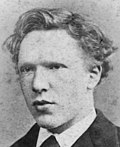
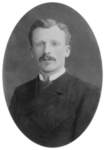



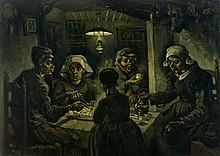


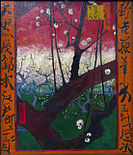
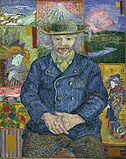



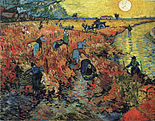


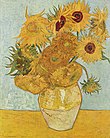

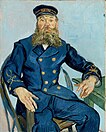



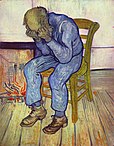
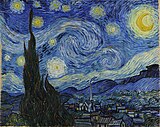
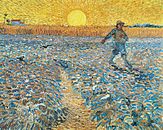


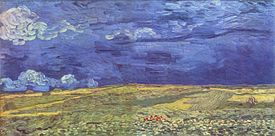





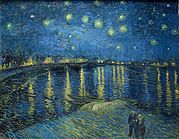



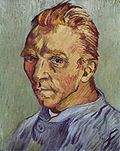



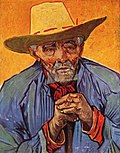
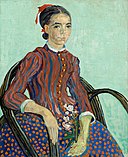
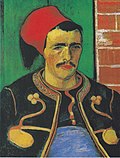

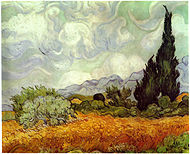

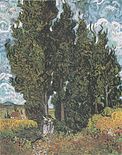






No comments:
Post a Comment
Please leave a comment-- or suggestions, particularly of topics and places you'd like to see covered